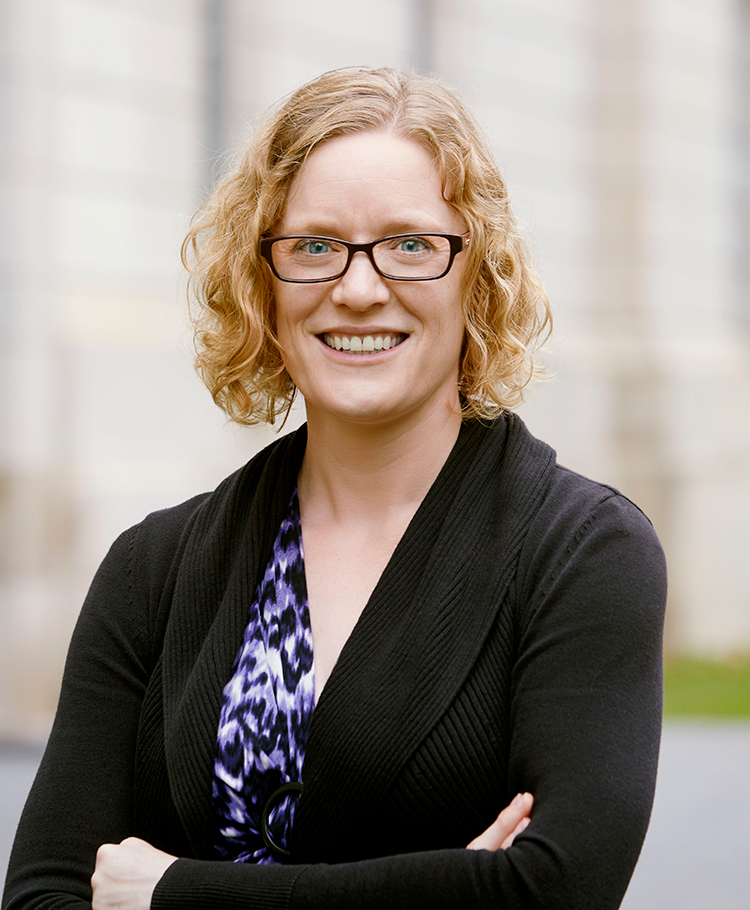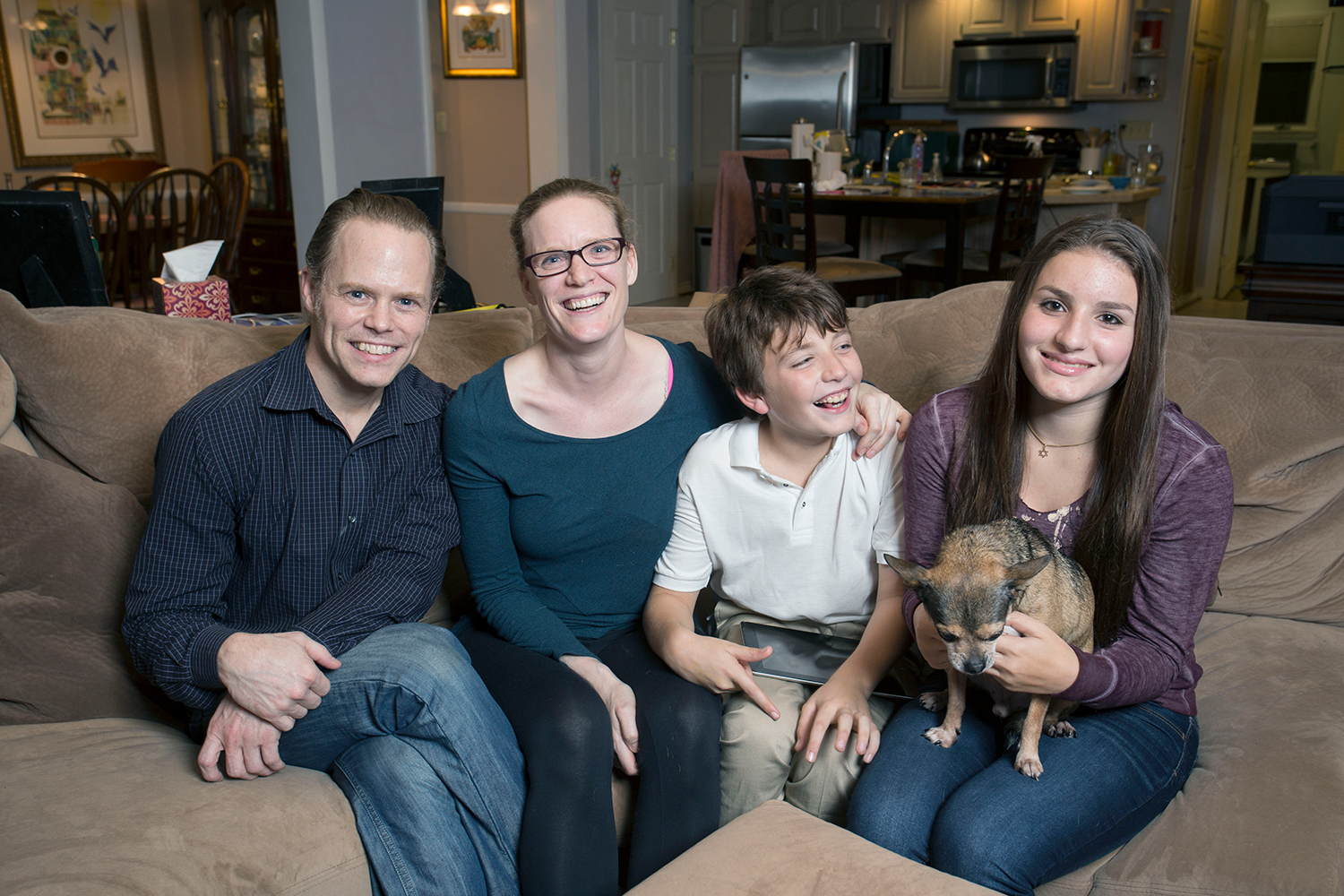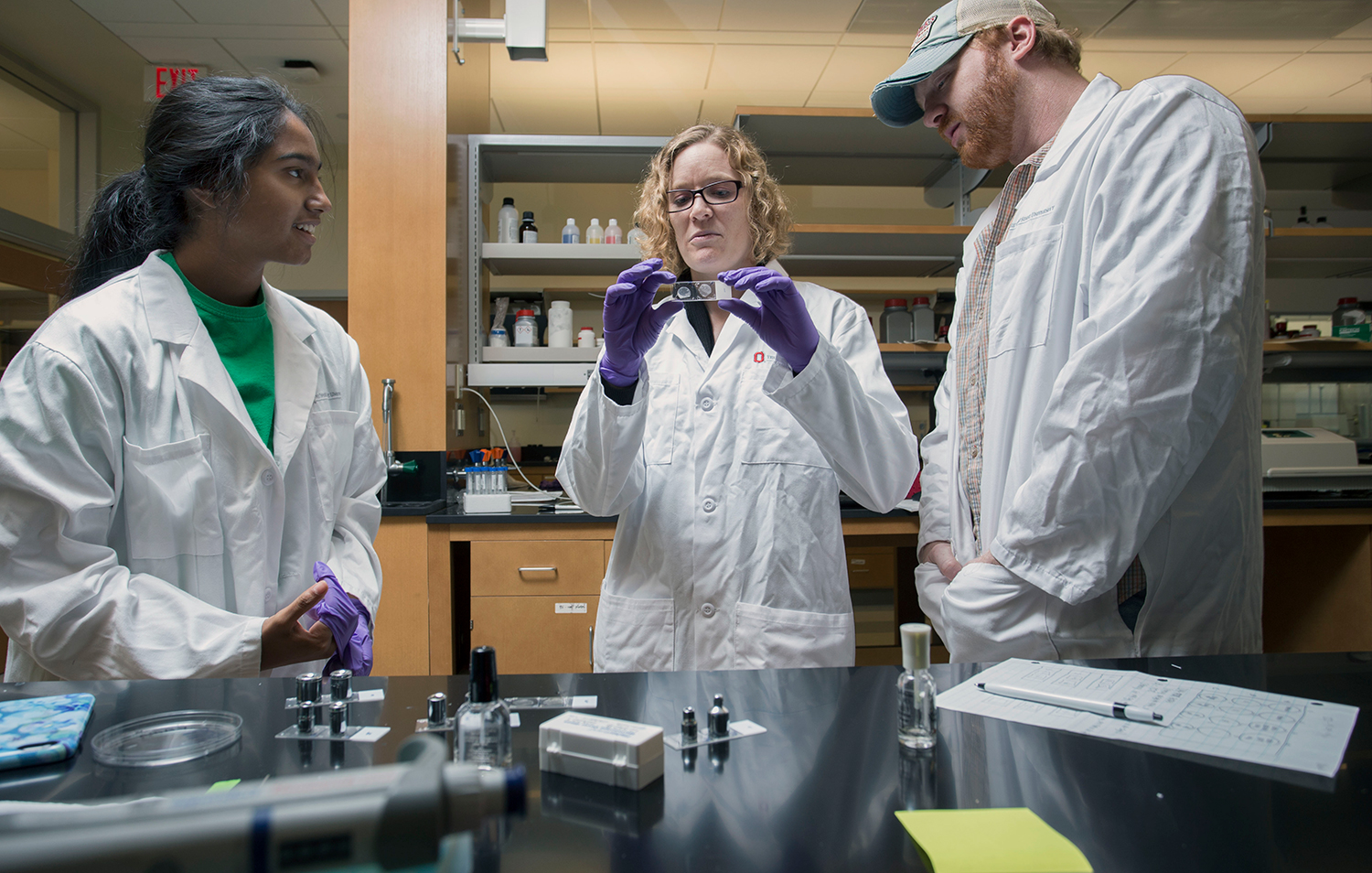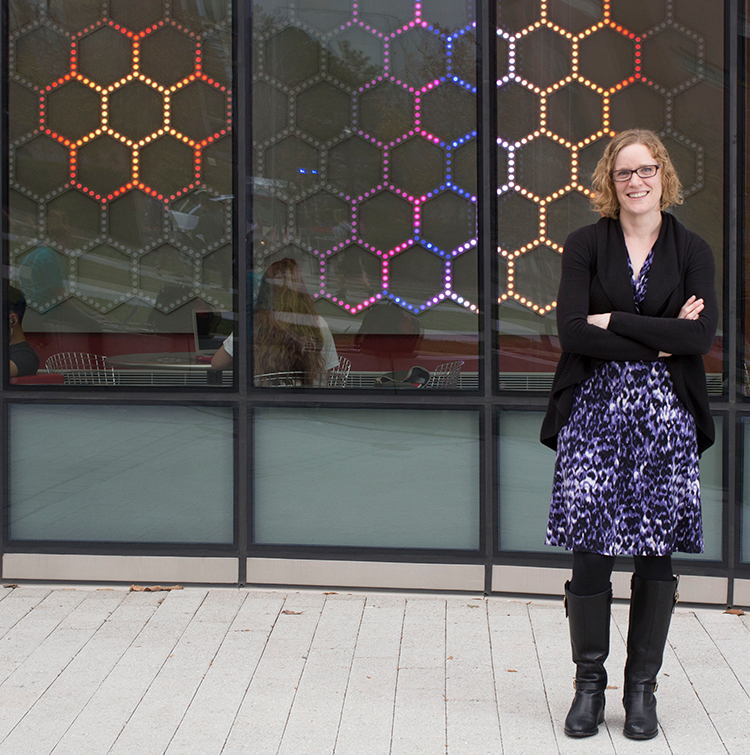AS CHEMOTHERAPY DRUGS coursed through her veins, biomedical engineer Jessica Winter tried to distract herself from her breast cancer treatment by writing grant proposals and reviewing scientific journals, part of her work leading a thriving research lab. But she kept asking herself the same question: “What am I doing with my life?”

Jessica Winter Photo by Jodi Miller
Winter, 40, is a professor of biomedical engineering at the Ohio State University in Columbus. She specializes in creating particles 1/10,000th the width of a human hair, called quantum dots, that light up on imaging scans when they attach to cancer cells in a tissue sample. The dots appear in a variety of colors, making it easier to identify cancer types. Over the past decade, Winter has tweaked the particles to be ever more sensitive to find and attach to specific types of cancer cells. Yet the progress made in her lab left her feeling hollow inside as she was treated with Adriamycin (doxorubicin) and Cytoxan (cyclophosphamide) for her stage III breast cancer.
Then Winter had an epiphany: She would no longer be content to make incremental improvements in cancer detection technology and publish the results in academic journals. She would shift her focus from pure research to figuring out how to turn her lab’s discoveries into diagnostic tools that could influence patients’ lives more quickly.
“I’m now more interested in creating things that make their way all the way to the patient,” she says. It’s one thing to publish research papers in journals. “But, in order to actually ever impact anyone, you have to take it to the next step.” The next step for her would include leading a new company to bring advanced technology to patients.
“Pretty Science-y”
Winter was born and raised in the Dallas-Fort Worth area. Her father was a physicist for General Dynamics, an aerospace and defense company, and her mother was a chemist for oil and cosmetic companies. In fact, most of her family members are physicians, scientists or engineers. “We’re all pretty science-y,” Winter says.
When she left home for college at Northwestern University in Evanston, Illinois, in 1993, the 1989 Exxon Valdez oil spill, an environmental catastrophe in Alaska, was still fresh in her mind. She was inspired to study environmental law, but she followed the advice of her uncle, a corporate lawyer, and started out focused on pre-law and chemical engineering. After her first semester, she decided to concentrate on chemical engineering.

Jessica Winter relaxes at home with her daughter, Ali; son, Max; and friend, Aaron Seamon. Ali holds their dog, Cutie. Photo by Jodi Miller
Following college and two years spent making semiconductor chips at Intel, Winter studied chemical and biomedical engineering at the University of Texas in Austin. Her primary project involved using nanoparticles to convert light into electricity and harnessing that energy to stimulate nerve cells in people with nerve damage. She continued this type of research at Ohio State, where she was hired as an assistant professor of chemical and biomolecular engineering after earning her doctorate in 2004. In her new lab, she also began creating quantum dots for labeling different molecular markers of cancer. At first, she created these particles to detect glioma, a type of brain cancer she was studying with powerful imaging equipment. Later, colleagues at Ohio State asked her to create similar quantum dots to identify cancer cells in breast tissue samples.
Three months into the breast cancer project, however, she detected a lump under her arm, and her work on breast cancer took a personal turn. It was 2011 and Winter was 35 years old.
“It was very surprising to me,” recalls Winter. “I was in the bathroom, getting ready to take a shower. I noticed when I raised my hand into the air, there was a lump that moved with my arm and it looked odd.”
Winter’s gynecologist told her it was likely just a cyst, but he advised her to get a mammogram. Three weeks later, Winter went to the Stefanie Spielman Comprehensive Breast Center in Columbus for the procedure. The Spielman Center is part of the Ohio State University Comprehensive Cancer Center. “Everything was in one place,” she says. “I had a mammogram in the morning, an ultrasound in the afternoon and two biopsies in the late afternoon.”
The diagnosis was stage III hormone receptor-positive, HER2-negative breast cancer. Instead of choosing a lumpectomy and another round of tests—one treatment option for patients in her situation—she opted for a mastectomy. “I said, ‘Just cut it off,’ ” she recalls. “I didn’t want to be thinking about it for a long time.”
Her decision was vindicated when, during surgery three weeks later, her doctors discovered three breast tumors that were deeply interconnected. “So, I would have had to have a mastectomy no matter what,” she says.
Winter made contingency plans for her job right away. She received her diagnosis on a Friday afternoon, and by the following Monday she had informed her department head, chemical and biomolecular engineer Stuart Cooper, that someone would need to take over her teaching load. Winter also gave instructions to her lab manager about keeping the lab running in her absence. The same day, she held an impromptu meeting with the students and technicians in her lab.
“They asked if they could do anything for me and I said, ‘Yeah, you can bring me good data to distract me from everything going on,’ ” she recalls.
Winter took three weeks off work following her mastectomy. A week later she began five months of chemotherapy, followed by three months of radiation. Her first reconstructive surgery was a few months after that. She had four more surgeries, “spaced out however long it took to heal from the time before,” she says. The entire experience, from diagnosis to the completion of her surgeries, took 18 months.
The first few rounds of chemotherapy wiped her out. She would work at her lab on Monday, go in for chemotherapy on Tuesday and take the rest of the week off. But even as she recuperated at home, she remained plugged in to the lab. “I like to joke that I ran my lab from a bed with an iPad,” she says.
These tiny crystals are increasingly being used to diagnose diseases such as cancer.
Quantum dots are tiny crystals—1/10,000th the width of a human hair—made of semiconductor materials such as silicon. The dots—used in solar cells, lasers, transistors, LEDs for flat-screen TVs, and medical imaging—are increasingly being used in research to diagnose diseases such as cancer. The dots can be attached to biomolecules that, in turn, can latch onto specific proteins on the surface of cancer cells. When poured onto a tissue sample in a dish and viewed under ultraviolet light, the quantum dots light up to indicate the presence of cancer. Pairing biomolecules that attach only to certain types of cancer cells with quantum dots that emit light of a specific color offers a powerful way to diagnose types of cancer and cancer mutations.
Winter’s quantum dots, which she calls “multidots,” are encapsulated in a special coating and bundled together in a beadlike structure. This packaging improves the nanoparticles’ brightness, longevity and stability compared with commercially available technologies. These improvements translate into better disease detection capability, and the multidots’ longer shelf life reduces the overall cost of diagnostic tests. Moreover, individual quantum dots within the multidot bundles can be different colors, meaning that multiple cancer markers can be imaged simultaneously, requiring less tissue for testing. Winter is seeking FDA approval for the multidots.
A New Direction
A few months into her treatment, Winter gathered her lab team together once more and told them about her epiphany in the chemo chair and her desire to more quickly turn the lab’s discoveries into diagnostic tools that could benefit patients. But changing course was not easy. Funds for turning basic laboratory discoveries into patient tests and treatments, known as translational research, are hard to come by.
In this video, Jessica Winter discusses how her research changed after a breast cancer diagnosis and offers advice for patients with cancer.
“In the middle of my treatment, I remember thinking, ‘I’m just not going to be able to do this,’ ” she recalls. But a group of her graduate students decided to make it happen. They completed patent applications for technologies used to produce quantum dots. Then, with help from Winter’s now former husband, financial analyst Adam Winter, they filed paperwork to start a company and made preparations to compete for funding in a small business competition sponsored by Ohio State. While her treatment continued, Winter offered advice to the students but ultimately took a back seat. Her students won the competition, and a few months later, in June 2012, while Winter was still undergoing reconstructive surgeries, they incorporated Core Quantum Technologies, with the mission of developing molecular tools to enhance the detection of cancer.
After her final surgery, Winter was able to take a more active role in the company as its chief science officer. “My students really carried it until that point,” she says.
“If you had to describe Dr. Winter in one word, it would be ‘unstoppable,’ ” says Kunal Parikh, one of three members of Winter’s lab who co-founded Core Quantum Technologies around the time he earned his undergraduate degree from Ohio State.
“Her experience with cancer probably gave her more perspective in terms of what’s the real value she could bring to people with the work she’s doing,” says Parikh, who began working in Winter’s lab as a senior in high school and is now a graduate student at Johns Hopkins University in Baltimore. “I find that kind of perspective to be really powerful.”
Core Quantum Technologies plans to conduct a clinical trial with the goal of securing approval from the U.S. Food and Drug Administration to use quantum dots in human tissue samples. The company’s technology, however, is not meant to be a first-line diagnostic tool. “That will remain imaging scans,” says Winter. The quantum dots “will be something a pathologist would use to define what type of cancer you have [in a tissue sample obtained during a biopsy] and what treatment you need.”
A Little Help From Her Friends
During Winter’s treatment, her family—including her mother, father, sister and mother-in-law—flew into town on alternating weekends to help out and to watch Winter’s then 9-year-old daughter, Ali, and 6-year-old son, Max. “We didn’t want the children to see how sick she really was,” says Winter’s mother, Joan Lutkenhaus. “When she was in bed recuperating, I kept the kitchen going and my husband helped with the kids.”
Her family also tried to distract Winter with movies and trips to video game palaces like Dave & Buster’s. “Those things worked, but there’s always that quiet moment where everything just comes flooding right back in and you can’t get rid of it,” says Winter.
“Even now, sometimes I will be in a [research] lecture and someone will start talking about cancer and statistics and odds and I will just have to get up and leave,” she says. “And it doesn’t even have to be breast cancer. It just gets to me. Other times I can be watching gory surgery videos and I’m fine. It’s really hard to predict.”
For her son, who was very worried while she was in treatment, Winter tried to put as positive a spin on her illness as possible. “I’m sick,” she recalls telling him, “but it’s like having a broken leg where they have to put a cast on you, and it takes a while, but then you’re better.” Her daughter, on the other hand, was concerned that she would get breast cancer, too. Winter learned she is negative for the BRCA1 and BRCA2 mutations, but genetic testing—performed as part of a clinical trial she enrolled in—indicated she has a CHEK2 mutation associated with a higher risk of breast cancer. She told her daughter, “Now that I’ve been diagnosed, you’ll start having mammograms at 25, and if you do have anything, they’ll be able to catch it before it becomes a problem.” Then the scientist-mom in her emerged, and she added, “And that’s so far away from now that you don’t even know where medical technology is going to be by then, so don’t worry about it.”
“She was very brave,” says Lutkenhaus of her daughter. “She kept a good face on for the sake of her children.”

In her lab, Jessica Winter reviews a brain tissue tumor model developed by graduate student Aaron Short, right, and area high school student Rama Balasubramaniam. Photo by Jodi Miller
Her colleagues at Ohio State also pitched in to help. “I’m one of those people that, when I get stressed, I don’t eat,” Winter says. So for the three weeks leading up to her mastectomy, the university had an informal “Take Jessica to Lunch” program—organized by materials scientist Mary Juhas, then an associate dean in the College of Engineering. Colleagues, some of whom Winter had never met, took her to lunch every day she was at work. “The university [administration] was very, very supportive,” says Winter.
Since her last surgery in August 2012, Winter has been on tamoxifen and will continue taking the drug until 2017, when she will switch to aromatase inhibitors to reduce her risk of a breast cancer recurrence. She will also get regular checkups and yearly scans. Winter says she eats healthy and always has. She also exercises every day, mostly yoga, which she had been doing regularly for a decade before her diagnosis, and enjoys hiking and belly dancing. “When I was diagnosed, I started to work out every day rather than twice a week,” she says. Between treatments, she eased back into her exercise routine with the approval of her physical therapists. “Every time I was just getting back up to speed, it was time for the next treatment, which was frustrating because I had to start over,” she adds.
Her chemotherapy and tamoxifen treatments have left Winter with joint pain, which prevents her from taking part in high-impact activities like running. Simple acts like throwing up her arms after a touchdown at an Ohio State football game can cause her pain.

Jessica Winter stands outside the Chemical and Biomolecular Engineering and Chemistry building at the Ohio State University in Columbus. Her research on quantum dots could advance cancer diagnosis. Photo by Jodi Miller
“One of the things that comforted me very much during all of this was being in nature,” she says, mentioning a hiking trail along the Olentangy River near Columbus’ Antrim Park. Before she got sick, she used to run the two-foot-wide trail, which is bordered by oak and pawpaw trees. Now she walks it with her Chihuahua. “He’ll walk for a bit,” she says. “Then he goes in the backpack.
“Being out there among the 100-year-old trees keeps everything in perspective,” she says, especially when challenges crop up in her newly refocused research. “At least I now know, though, this is what I want to do, and if I’m not successful, then so be it. But I’m not going to not try.”
Cancer Today magazine is free to cancer patients, survivors and caregivers who live in the U.S. Subscribe here to receive four issues per year.




